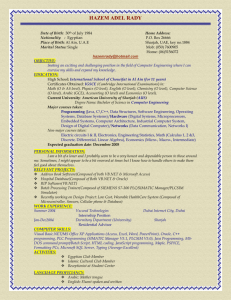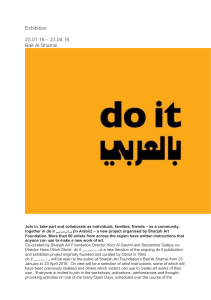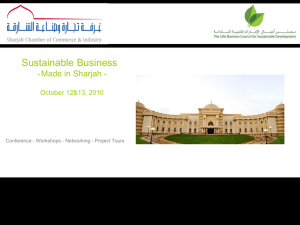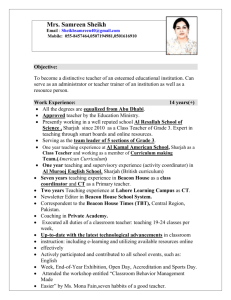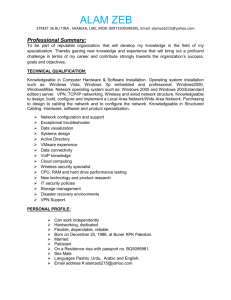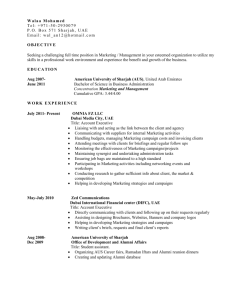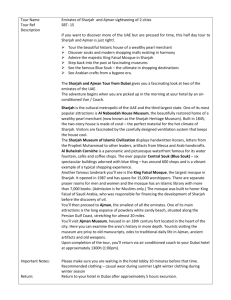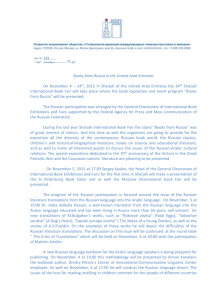Sharjah 2020: Vision Plan - Caspian Associates, Inc.
advertisement
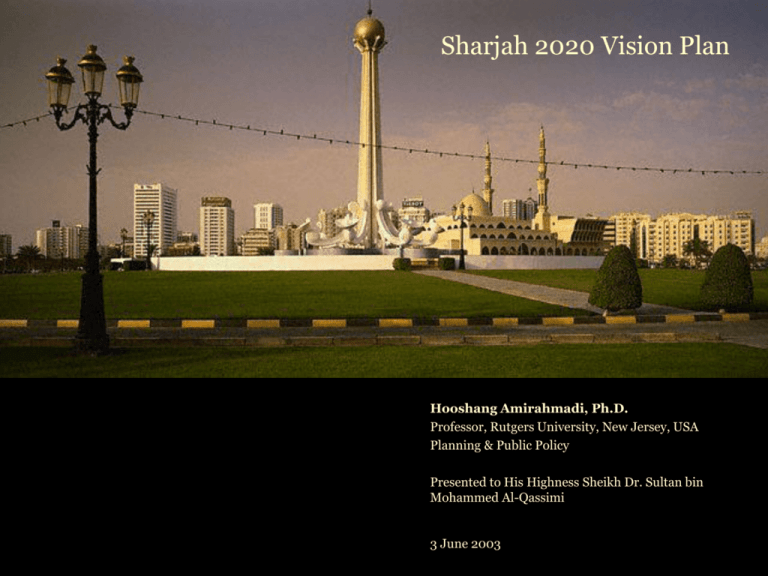
Sharjah 2020 Vision Plan Hooshang Amirahmadi, Ph.D. Professor, Rutgers University, New Jersey, USA Planning & Public Policy Presented to His Highness Sheikh Dr. Sultan bin Mohammed Al-Qassimi 3 June 2003 Presentation Overview – – – – Introduction Purpose of the Vision 2020 Plan Methodology of Vision Planning Phases of Vision Planning • Phase I: Present State of Sharjah – Marketing Package • Phase II: Sharjah’s Challenges – Challenge Report • Phase III: Vision Planning – Sharjah 2020 Vision Plan – Plan Development – Plan Evaluation – Educational Workshops – Getting Started Introduction The purpose of the proposed project is to develop a Vision 2020 Plan for the Emirate of Sharjah under the patronage of His Highness Sheikh Dr. Sultan bin Mohammed Al-Qassimi, Member of the Supreme Council of the UAE, and the Ruler of Sharjah. The proposed Vision 2020 Plan will function as a “road map” to help His Highness lead Sharjah in accordance with a vision that will combine His wishes for Sharjah, the Emirate’s capacities, and the possibilities offered by the new country. The proposed Vision 2020 Plan will improve Sharjah’s stature as a regional magnet, enhance the quality of life for Sharjah’s residents, increase Sharjah’s competitive advantages, and assist its planned regional and global integration. The Plan preparation will go through three (3) phases: 1) Present State of Sharjah; 2) Sharjah’s Challenges; and 3) Vision Planning. The products will include a Marketing Package, a Challenge Report, and a Vision 2020 Plan for Sharjah. This proposal excludes the implementation phase of the Vision 2020 Plan, but it provides the benchmarks and guidelines for implementation. During this phase, the experts behind this proposal could act as consultants if His Highness so desires. Purpose of the Vision 2020 Plan “No Country Has Developed without a Vision and a Plan.” The purpose of the Vision 2020 Plan for Sharjah is: • • • • • • • • To assist with strategic thinking and maintaining it through strategic management To aid the leadership in designing the future and meeting challenges innovatively To cope with the turbulence of a modern world where uncertainty is the norm To ensure sustainability and consistency in implementation To prevent fragmented and conflicting decision making To meet the rising expectations of Sharjah’s residents To advance development planning and strategic management To develop a unique Sharjah “brand” and showcase its competitive advantages Methodology of Vision Planning Vision Planning involves five (5) steps: Step 1: Pre-planning Studies – Investigation of Existing Situation – Identification of Gaps & Challenges Step 2: Creation of Strategic Vision – Design of a desired future for Sharjah – Map of a competitive position for Sharjah – Inventory of goals to be achieved Step 3: Evaluation of Vision Statement – Identification of critical issues (challenges) – Decomposition of issues into activity areas (themes) – Selection of actionable themes and possible ways forward Methodology of Vision Planning cont’d. Step 4: Restatement of Vision – Modification of vision to confirm evaluation results – Application of the criteria for a “challenging vision” Step 5: Backward Deployment – Decomposition of vision into actionable projects – Establishment of implementation benchmarks – Institutionalization of strategic management Vision Planning Phases Phase I: Present State of Sharjah – Achievement Highlights – Marketing Package (Public) Phase II: Sharjah’s Challenges – Existing Gaps – Future Vision – Challenge Report (Private) Phase III: Vision Planning – – – – Plan Development Plan Evaluation Educational Workshops Vision 2020 Plan (Semi-Private) Phase I: Present State of Sharjah Purpose: Highlight Sharjah’s tremendous achievements in the last two decades and identify critical issues Activities: Identify progresses made and issues present in the areas of: – Culture & Recreation – Education & Human Development – Industry & Services – Urban and Community Development Product: Marketing Package, which can be used to further attract: – Tourists & Cultural Groups – Students, Faculty & Researchers – Global & Regional Investors – Local Population and Prospective Residents Marketing Package Objective: Promote a unique Sharjah “brand” and showcase its competitive advantages Contents: Marketing Package will consist of: – Marketing Plan – Identity System & Guidelines (Logo, Color Schemes, etc.) – Naming System & Guidelines – Wayfinding System & Guidelines – Internationalization Standards – Slogan or Motto – Website Portal – Promotional Brochures or Fact Sheets – Promotional Video – Television Commercial – Print Advertisements Phase II: Sharjah’s Challenges Purpose: Identify areas needing additional development with a view to: – Integrating Sharjah’s many achievements – Strengthening Sharjah’s sense of community – Distinguishing Sharjah’s unique identity Activities: Undertake the following activities: – Capacity & Constraint Analysis – Competitive Advantage Analysis – Futuristic & Predictive Analysis Product: Sharjah’s Challenge Report, which will include the major gaps and challenges the Emirate is facing in order to further and sustain its development. Challenge Report Objective: Review successful development in Sharjah and identify areas for improvement. Contents: Challenge Report consists of four (4) sections: – Gaps & Inconsistencies Analysis – Capacity & Constraints Analysis – Competitive Advantages Analysis – Futuristic & Predictive Analysis Phase III: Vision Planning Purpose: Design a “road map,” which Sharjah needs in order to navigate toward a more prosperous future. Activities: Undertake activities related to the following tasks: – Plan Development – Plan Evaluation – Workshop Planning Product: Sharjah’s Vision 2020 Plan. It depicts the future developed image of Sharjah, and provides the systematic path for arriving at that stage. Sharjah 2020 Vision Plan Objective: Formulate strategies, guidelines, and programs for different stages of Sharjah’s longterm development process. Contents: Vision 2020 Plan includes: – The future of Sharjah in the region and beyond – Long-term vision of Sharjah’s development – Strategic goals to achieve the vision – Objectives of different stages of development – Medium-term plan and programs – Short-term plan and programs – Stage-wise evaluation plan – Requirements for achieving the planned vision Plan Development Sharjah 2020 Vision Plan will be conceptualized at three (3) scales: – National – Regional – Global Each with four (4) dimensions: – – – – Economic Social/Cultural Institutional Spatial and physical And each from three (3) perspectives: – Macro, involving Scenario Building & Selection – Meso, involving Strategy Development – Micro, involving Policy Formulation Vision Planning: Model of Scenario Building Global Development Perspective National Capabilities & Constraints National Values & Principles National Needs & Demands Scenarios for Sharjah’s Role & Place in the Region & Beyond National Trends & Patterns of Development Scenarios For Economic Development Social & Cultural Development Images Spatial Development Images Political Development Images Regional Development Perspective NATIONAL SECTORAL / SPATIAL Vision Planning: Model of Development Scenarios Alternative Paths of National Development Role & Place in the World Global Integration Regional Integration Economic Development Framework • Export promotion • Free trade policy/privatization • Reliance on world markets • Joint foreign investments • Multi-sectoral development (comparative & competitive) • Technological alliances • Selective trade policy • Reliance on regional markets • Regional economic cooperation • Targeted sectoral development • Regional infrastructure • Mixed-sectoral development (comparative & competitive) • Import substitution • Economic protectionism • Strategic self-sufficiency • Reliance on domestic market • Local resource dependency • Mono-sectoral development (comparative advantage) Tradition & Modernity • Globalism • Modernization • Mass culture • Regionalism • Nationalism • Culturalism • Nationalism • Localism • Traditionalism • Government as coordinator • Decentralization • Private Sector as leader • Government as leader • Controlled decentralization • Private Sector as actor • Government as controller • Centralization • Private Sector as follower State & People National Isolation Vision Planning: Model of Goal, Strategy, Objective and Policy Formulation Growth & Competitiveness Prosperity & Unity Integration of Space Maximization of National Interest & Public Participation Strategy Economic Strategies Social Strategies Spatial Strategies Political Strategies Objective Economic Objectives Social Objectives Spatial Objectives Political Objectives Policy Economic Policies Social Policies Spatial Policies Political Policies Goal Plan Evaluation Sharjah 2020 Vision Plan will be evaluated: – Internally by the expert team and the Government of Sharjah – Externally by an independent team of consultants Using qualitative and quantitative criteria developed within the Plan, including: – – – – – His Highness’ Preferences & Values Established Goals & Objectives Public Expectations Internal Participation Situational Comparison Educational Workshops After the Plan is finalized and submitted to His Highness, the expert team will organize a series of workshops designed to: – – – – Facilitate a better understanding of the Plan Expand internal planning capabilities Encourage locals to take ownership of the Vision Ensure proper plan implementation Getting Started Should His Highness wish to use Vision Planning to ready Sharjah for a more competitive future, these issues need to be immediately addressed: – – – – – Time Management (CPM) Internal Preparation Summary Team Demographic Summary Budget Summary Logistics Summary Internal Preparation Summary His Highness will need to: – Communicate his approval of the project to those people and organizations that he deems necessary. – Designate a government office to take ownership of the project, preferably within his own office. – Appoint an official to serve as his representative for the project and to work with the Project Director. Project Director will need to: – – – – – Appoint two (2) Project Coordinators to operate from Sharjah and New York City. Retain expert consultants for the project. Prepare administrative protocol and information technology for the project. Develop project orientation material, including an orientation to Sharjah. Outline planning tasks, schedule milestones, and assign activities to consultants. Team Demographic Summary The consulting team will represent a balanced mix of individuals from: – – – – Academic and professional planning communities. Middle Eastern and Western educational and training backgrounds. Traditional and modern belief systems. Different areas of specialization with experience in diverse cultural settings. Key areas of specialization include: – – – – – – – – – Territorial & Sectoral Planning Strategy & Policy Development Vision Building & Strategic Management Forecasting & Statistical Analysis Geographic Information Systems System & Structure Analysis Global & Regional Studies Competitive & Comparative Analysis Marketing & Brand Strategy Budget Summary The estimated cost of Sharjah 2020 Vision Plan is US $1,895,000. This figure comprises: – Consulting Fees: US $1,270,000 equivalent to US $60 per hour • Includes salaries for 10 full-time consultants and U.S. Gov’t. taxes (~20%) – Out-of-Pocket Expenses: US $530,000 • Includes expenses for per diems, airfare, hotels, and transportation – Overhead: US $85,000 • Includes expenses for specialized equipment, office space, communications, etc. – Miscellaneous: US $10,000 The details of the budget are included in the presentation booklet. Logistics Summary Start Date: ………………. As soon as August 2003 Timeline: ………………….Twelve (12) months Location: …………………. Sharjah, UAE and New York City, USA Reporting: ……………….. Monthly & Quarterly (for His Highness) Director: …………………..One (1), Hooshang Amirahmadi, Ph.D. Coordinators: ……………Two (2), Sharjah and USA Delivery: …………………. Formal presentation to His Highness in Sharjah Retainer: …………………. Twenty-five percent (25%) of total budget Expenses: ………………… Reimbursed as incurred and per invoice Consulting Fees: ………. Paid monthly to Project Director per his report The logistics details are included in the presentation booklet. Conclusion We thank His Highness for the opportunity to share our approach to helping Sharjah envision its future. Dr. Amirahmadi can be contacted at: Professor Dr. Hooshang Amirahmadi Edward J. Bloustein School of Planning & Public Policy Rutgers, State University of New Jersey 33 Livingston Campus, Suite 302 New Brunswick, NJ 08901 USA Mobile: 001.609.937.6488 Facsimile: 001.609.279.9889 Email: amirahma@rci.rutgers.edu
